engine KIA Optima 2006 2.G Owner's Guide
[x] Cancel search | Manufacturer: KIA, Model Year: 2006, Model line: Optima, Model: KIA Optima 2006 2.GPages: 225, PDF Size: 3.77 MB
Page 90 of 225
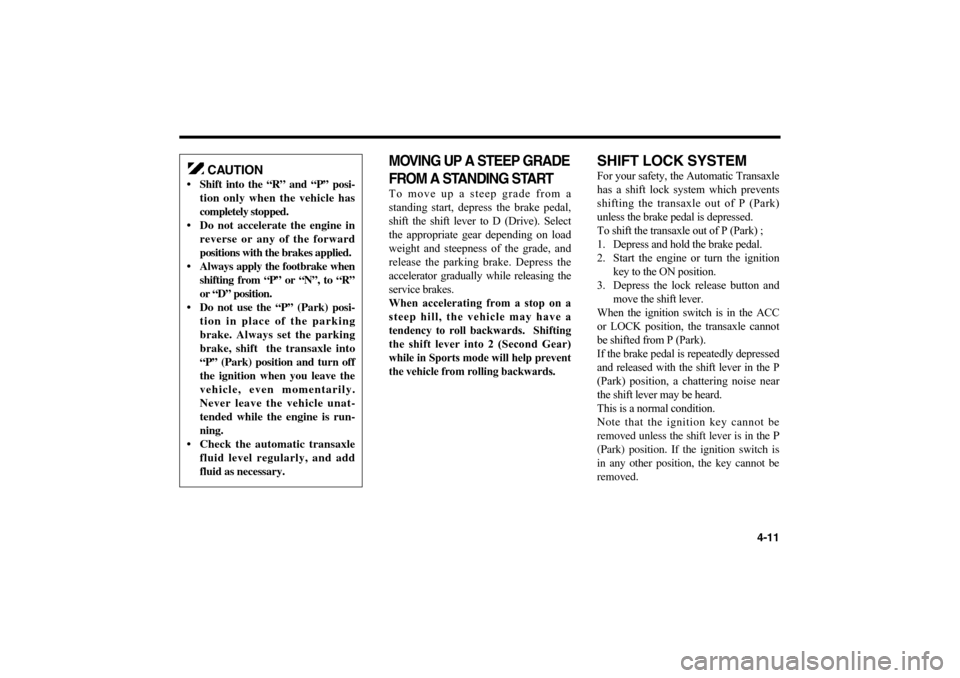
MOVING UP A STEEP GRADE
FROM A STANDING STARTTo move up a steep grade from a
standing start, depress the brake pedal,
shift the shift lever to D (Drive). Select
the appropriate gear depending on load
weight and steepness of the grade, and
release the parking brake. Depress the
accelerator gradually while releasing the
service brakes.
When accelerating from a stop on a
steep hill, the vehicle may have a
tendency to roll backwards. Shifting
the shift lever into 2 (Second Gear)
while in Sports mode will help prevent
the vehicle from rolling backwards.
SHIFT LOCK SYSTEMFor your safety, the Automatic Transaxle
has a shift lock system which prevents
shifting the transaxle out of P (Park)
unless the brake pedal is depressed.
To shift the transaxle out of P (Park) ;
1. Depress and hold the brake pedal.
2. Start the engine or turn the ignition
key to the ON position.
3. Depress the lock release button and
move the shift lever.
When the ignition switch is in the ACC
or LOCK position, the transaxle cannot
be shifted from P (Park).
If the brake pedal is repeatedly depressed
and released with the shift lever in the P
(Park) position, a chattering noise near
the shift lever may be heard.
This is a normal condition.
Note that the ignition key cannot be
removed unless the shift lever is in the P
(Park) position. If the ignition switch is
in any other position, the key cannot be
removed.
4-11
CAUTION
Shift into the “R” and “P” posi-
tion only when the vehicle has
completely stopped.
Do not accelerate the engine in
reverse or any of the forward
positions with the brakes applied.
Always apply the footbrake when
shifting from “P” or “N”, to “R”
or “D” position.
Do not use the “P” (Park) posi-
tion in place of the parking
brake. Always set the parking
brake, shift the transaxle into
“P” (Park) position and turn off
the ignition when you leave the
vehicle, even momentarily.
Never leave the vehicle unat-
tended while the engine is run-
ning.
Check the automatic transaxle
fluid level regularly, and add
fluid as necessary.
MS-CNA-Eng 4(~39).QXD 7/25/2005 5:16 PM Page 11
Page 91 of 225
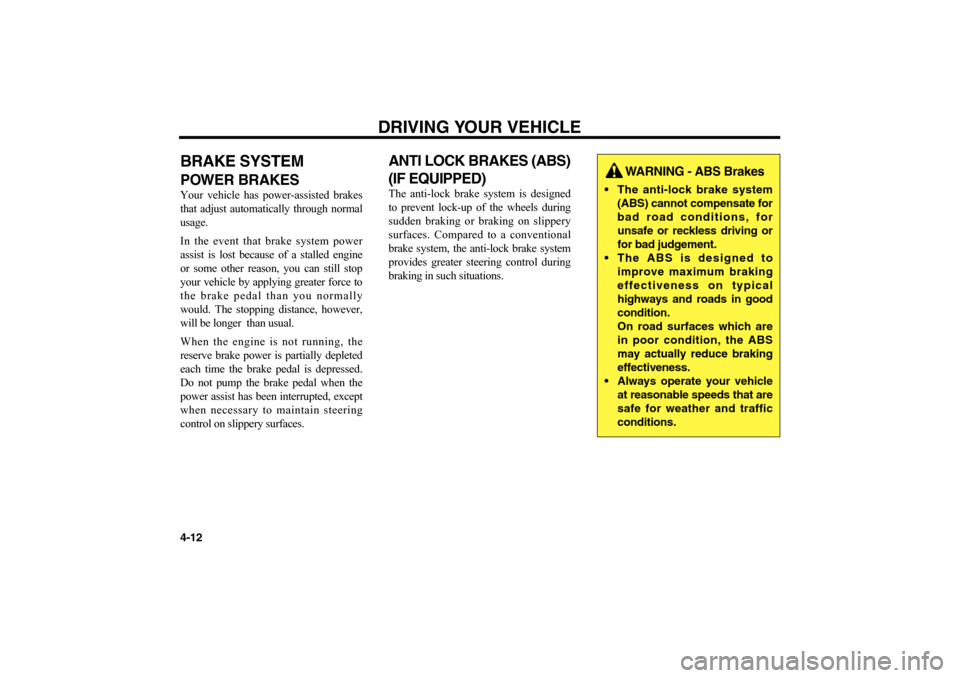
BRAKE SYSTEMPOWER BRAKESYour vehicle has power-assisted brakes
that adjust automatically through normal
usage.
In the event that brake system power
assist is lost because of a stalled engine
or some other reason, you can still stop
your vehicle by applying greater force to
the brake pedal than you normally
would. The stopping distance, however,
will be longer than usual.
When the engine is not running, the
reserve brake power is partially depleted
each time the brake pedal is depressed.
Do not pump the brake pedal when the
power assist has been interrupted, except
when necessary to maintain steering
control on slippery surfaces.
ANTI LOCK BRAKES (ABS)
(IF EQUIPPED)The anti-lock brake system is designed
to prevent lock-up of the wheels during
sudden braking or braking on slippery
surfaces. Compared to a conventional
brake system, the anti-lock brake system
provides greater steering control during
braking in such situations.DRIVING YOUR VEHICLE
4-12
WARNING - ABS Brakes
The anti-lock brake system
(ABS) cannot compensate for
bad road conditions, for
unsafe or reckless driving or
for bad judgement.
The ABS is designed to
improve maximum braking
effectiveness on typical
highways and roads in good
condition.
On road surfaces which are
in poor condition, the ABS
may actually reduce braking
effectiveness.
Always operate your vehicle
at reasonable speeds that are
safe for weather and traffic
conditions.
MS-CNA-Eng 4(~39).QXD 7/25/2005 5:16 PM Page 12
Page 93 of 225
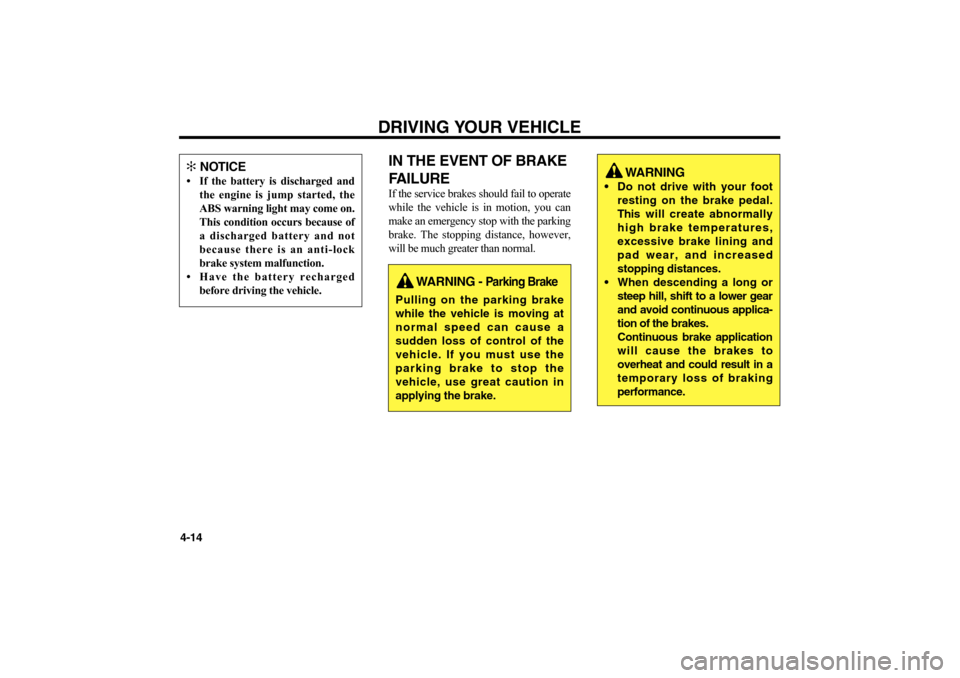
IN THE EVENT OF BRAKE
FAILUREIf the service brakes should fail to operate
while the vehicle is in motion, you can
make an emergency stop with the parking
brake. The stopping distance, however,
will be much greater than normal.DRIVING YOUR VEHICLE
4-14✻
NOTICE
• If the battery is discharged and
the engine is jump started, the
ABS warning light may come on.
This condition occurs because of
a discharged battery and not
because there is an anti-lock
brake system malfunction.
• Have the battery recharged
before driving the vehicle.
WARNING -
Parking Brake
Pulling on the parking brake
while the vehicle is moving at
normal speed can cause a
sudden loss of control of the
vehicle. If you must use the
parking brake to stop the
vehicle, use great caution in
applying the brake.
WARNING
Do not drive with your foot
resting on the brake pedal.
This will create abnormally
high brake temperatures,
excessive brake lining and
pad wear, and increased
stopping distances.
When descending a long or
steep hill, shift to a lower gear
and avoid continuous applica-
tion of the brakes.
Continuous brake application
will cause the brakes to
overheat and could result in a
temporary loss of braking
performance.
MS-CNA-Eng 4(~39).QXD 7/25/2005 5:16 PM Page 14
Page 96 of 225
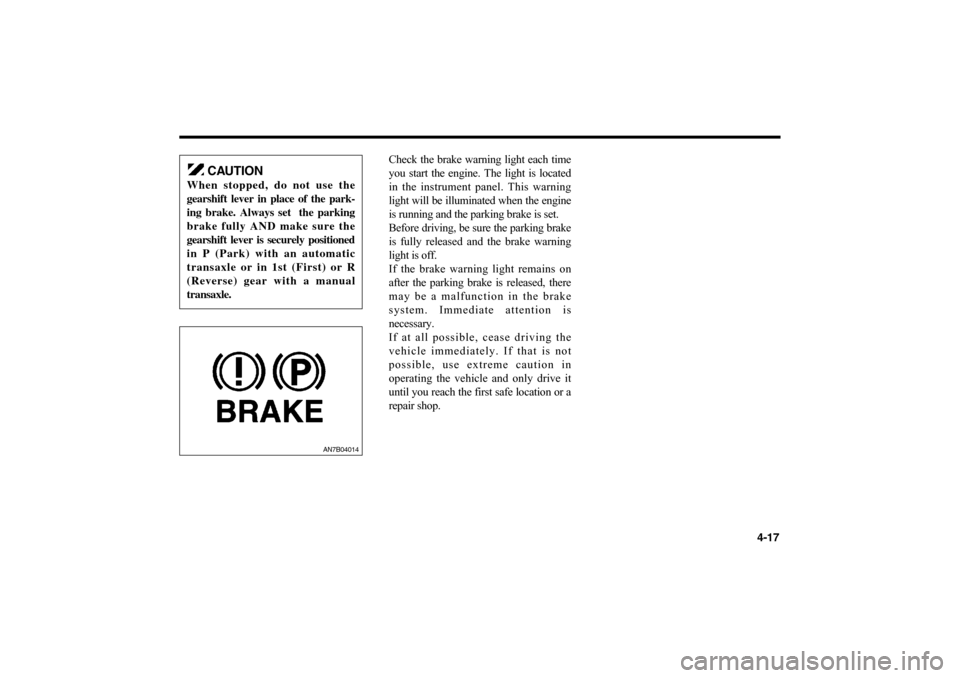
Check the brake warning light each time
you start the engine. The light is located
in the instrument panel. This warning
light will be illuminated when the engine
is running and the parking brake is set.
Before driving, be sure the parking brake
is fully released and the brake warning
light is off.
If the brake warning light remains on
after the parking brake is released, there
may be a malfunction in the brake
system. Immediate attention is
necessary.
If at all possible, cease driving the
vehicle immediately. If that is not
possible, use extreme caution in
operating the vehicle and only drive it
until you reach the first safe location or a
repair shop.
4-17
AN7B04014
CAUTION
When stopped, do not use the
gearshift lever in place of the park-
ing brake. Always set the parking
brake fully AND make sure the
gearshift lever is securely positioned
in P (Park) with an automatic
transaxle or in 1st (First) or R
(Reverse) gear with a manual
transaxle.
MS-CNA-Eng 4(~39).QXD 7/25/2005 5:16 PM Page 17
Page 97 of 225
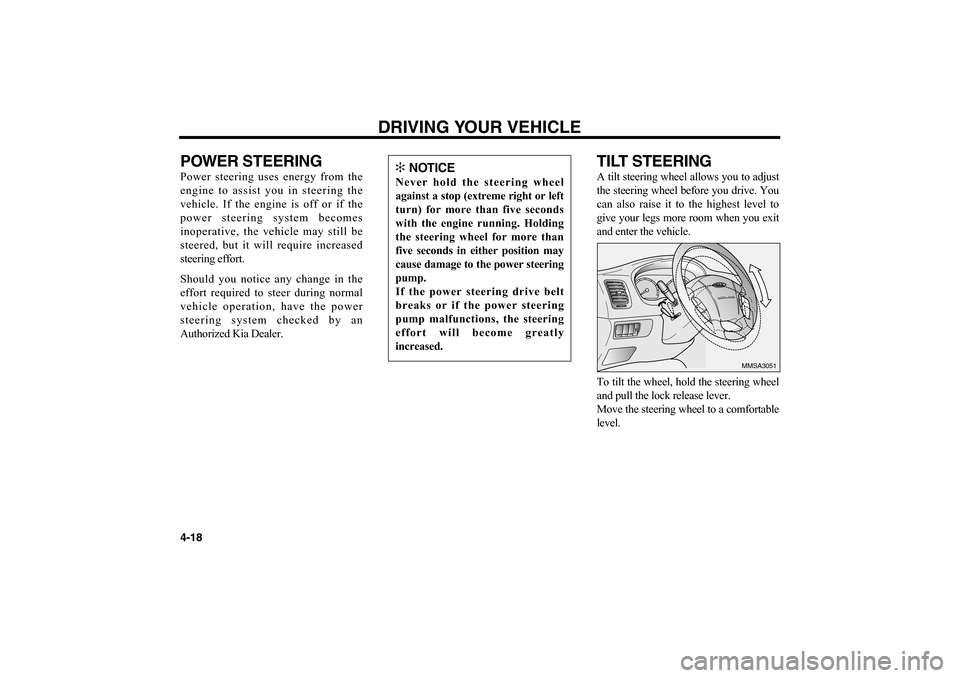
POWER STEERING Power steering uses energy from the
engine to assist you in steering the
vehicle. If the engine is off or if the
power steering system becomes
inoperative, the vehicle may still be
steered, but it will require increased
steering effort.
Should you notice any change in the
effort required to steer during normal
vehicle operation, have the power
steering system checked by an
Authorized Kia Dealer.
TILT STEERINGA tilt steering wheel allows you to adjust
the steering wheel before you drive. You
can also raise it to the highest level to
give your legs more room when you exit
and enter the vehicle.
To tilt the wheel, hold the steering wheel
and pull the lock release lever.
Move the steering wheel to a comfortable
level.
DRIVING YOUR VEHICLE
4-18
MMSA3051
✻
NOTICE
Never hold the steering wheel
against a stop (extreme right or left
turn) for more than five seconds
with the engine running. Holding
the steering wheel for more than
five seconds in either position may
cause damage to the power steering
pump.
If the power steering drive belt
breaks or if the power steering
pump malfunctions, the steering
effort will become greatly
increased.
MS-CNA-Eng 4(~39).QXD 7/25/2005 5:16 PM Page 18
Page 98 of 225
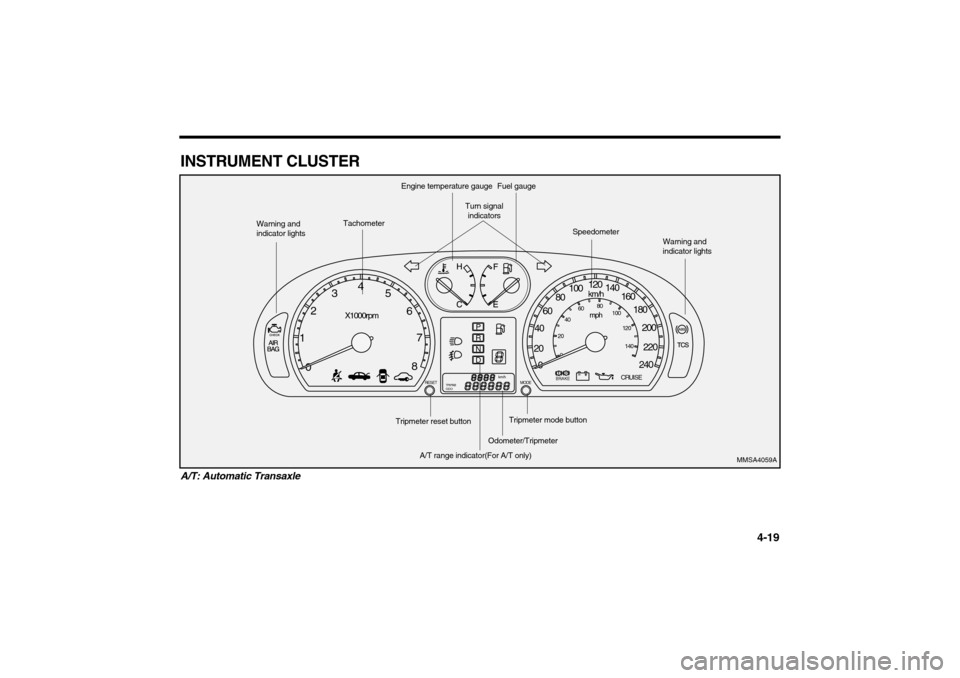
INSTRUMENT CLUSTER
4-19
A/T: Automatic Transaxle
0 1234
5
6
7
8
X1000rpm
PRND
RESET MODE
BRAKE
CRUISE
TRIPAB
ODO
km/h
0 20406080100120
140
160
180
200
220
240
km/hmph
0 20406080
100
120
140
MMSA4059A
Warning and
indicator lights
Tachometer
Engine temperature gauge
Turn signal
indicators
Fuel gauge
Speedometer
Warning and
indicator lights
A/T range indicator(For A/T only)
Odometer/Tripmeter
Tripmeter mode button
Tripmeter reset button
MS-CNA-Eng 4(~39).QXD 7/25/2005 5:16 PM Page 19
Page 99 of 225
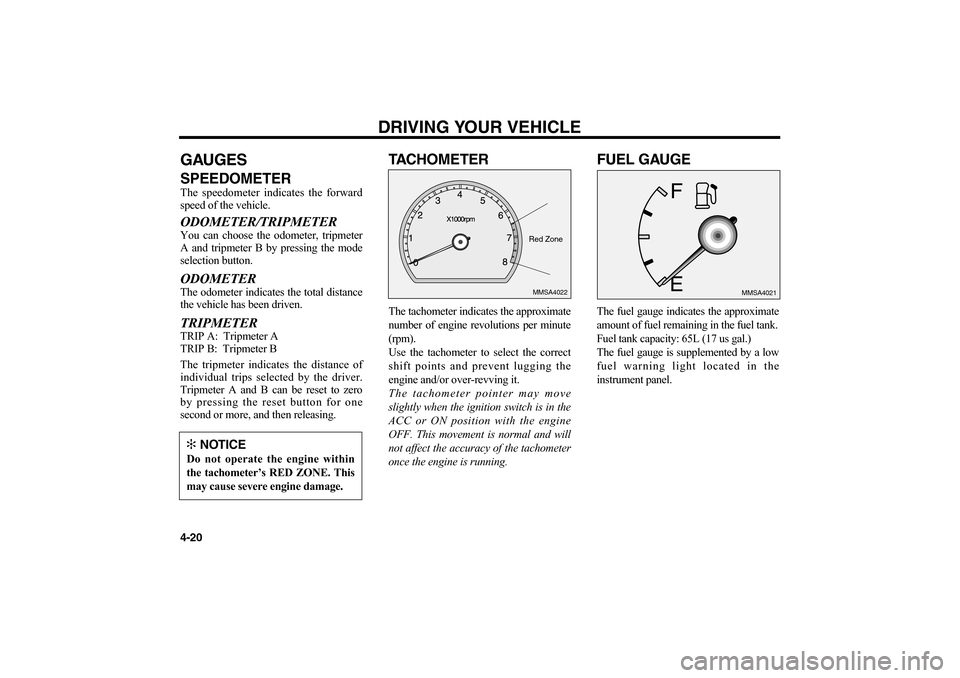
DRIVING YOUR VEHICLE
4-20GAUGESSPEEDOMETERThe speedometer indicates the forward
speed of the vehicle.ODOMETER/TRIPMETERYou can choose the odometer, tripmeter
A and tripmeter B by pressing the mode
selection button.ODOMETERThe odometer indicates the total distance
the vehicle has been driven.TRIPMETERTRIP A: Tripmeter A
TRIP B: Tripmeter B
The tripmeter indicates the distance of
individual trips selected by the driver.
Tripmeter A and B can be reset to zero
by pressing the reset button for one
second or more, and then releasing.
TACHOMETERThe tachometer indicates the approximate
number of engine revolutions per minute
(rpm).
Use the tachometer to select the correct
shift points and prevent lugging the
engine and/or over-revving it.
The tachometer pointer may move
slightly when the ignition switch is in the
ACC or ON position with the engine
OFF. This movement is normal and will
not affect the accuracy of the tachometer
once the engine is running.
FUEL GAUGEThe fuel gauge indicates the approximate
amount of fuel remaining in the fuel tank.
Fuel tank capacity: 65L (17 us gal.)
The fuel gauge is supplemented by a low
fuel warning light located in the
instrument panel.
MMSA4021
MMSA4022Red Zone
✻
NOTICE
Do not operate the engine within
the tachometer’s RED ZONE. This
may cause severe engine damage.
MS-CNA-Eng 4(~39).QXD 7/25/2005 5:16 PM Page 20
Page 100 of 225
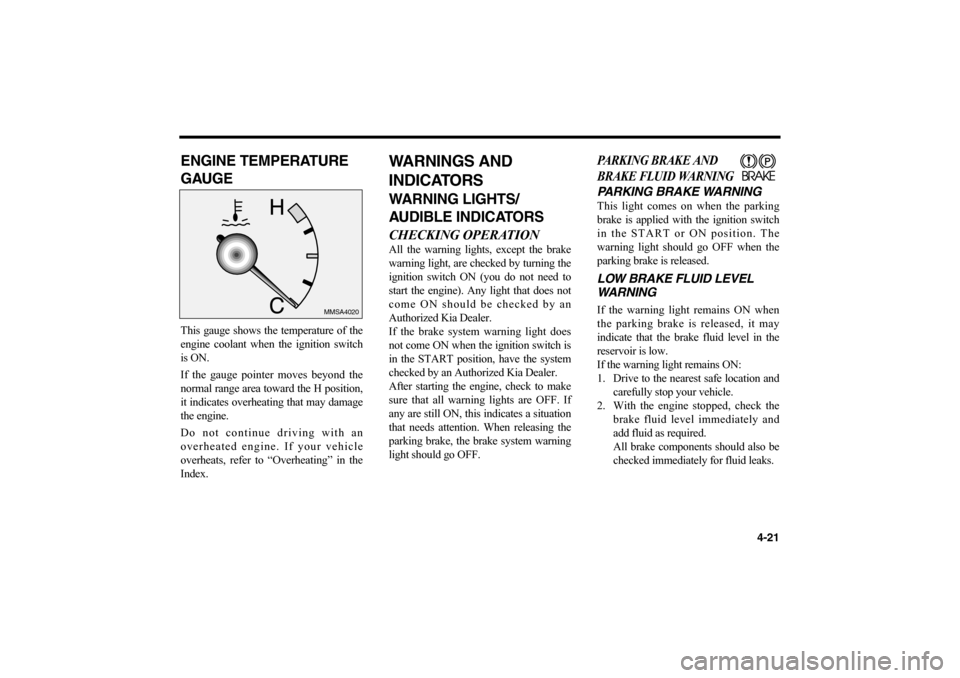
ENGINE TEMPERATURE
GAUGEThis gauge shows the temperature of the
engine coolant when the ignition switch
is ON.
If the gauge pointer moves beyond the
normal range area toward the H position,
it indicates overheating that may damage
the engine.
Do not continue driving with an
overheated engine. If your vehicle
overheats, refer to “Overheating” in the
Index.
WARNINGS AND
INDICATORSWARNING LIGHTS/
AUDIBLE INDICATORSCHECKING OPERATIONAll the warning lights, except the brake
warning light, are checked by turning the
ignition switch ON (you do not need to
start the engine). Any light that does not
come ON should be checked by an
Authorized Kia Dealer.
If the brake system warning light does
not come ON when the ignition switch is
in the START position, have the system
checked by an Authorized Kia Dealer.
After starting the engine, check to make
sure that all warning lights are OFF. If
any are still ON, this indicates a situation
that needs attention. When releasing the
parking brake, the brake system warning
light should go OFF.
PARKING BRAKE AND
BRAKE FLUID WARNINGPARKING BRAKE WARNINGThis light comes on when the parking
brake is applied with the ignition switch
in the START or ON position. The
warning light should go OFF when the
parking brake is released.LOW BRAKE FLUID LEVEL
WARNINGIf the warning light remains ON when
the parking brake is released, it may
indicate that the brake fluid level in the
reservoir is low.
If the warning light remains ON:
1. Drive to the nearest safe location and
carefully stop your vehicle.
2. With the engine stopped, check the
brake fluid level immediately and
add fluid as required.
All brake components should also be
checked immediately for fluid leaks.
4-21
MMSA4020
MS-CNA-Eng 4(~39).QXD 7/25/2005 5:16 PM Page 21
Page 101 of 225
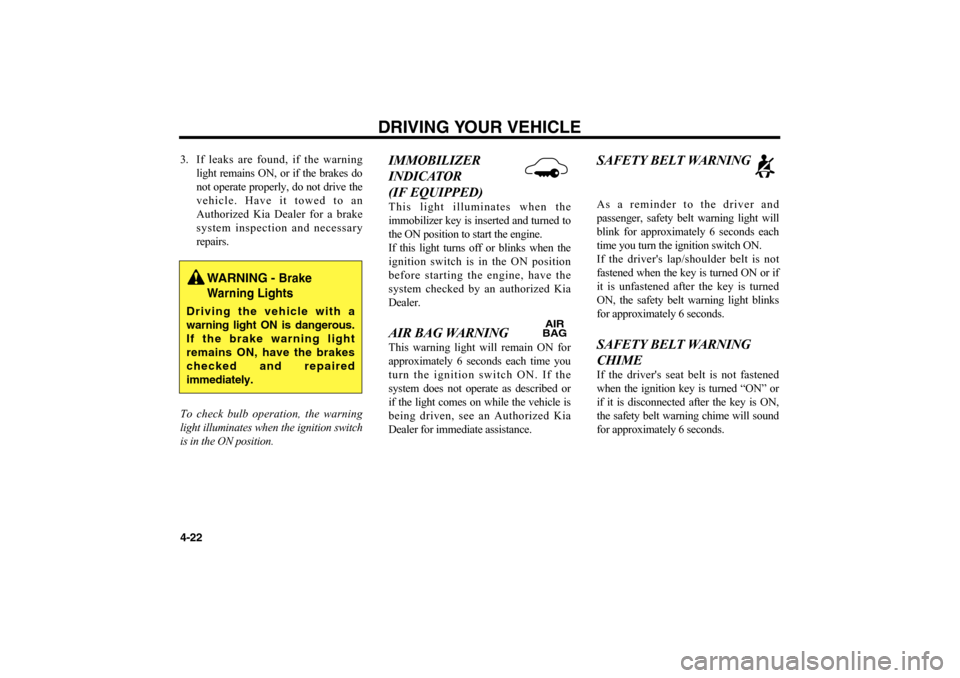
3. If leaks are found, if the warning
light remains ON, or if the brakes do
not operate properly, do not drive the
vehicle. Have it towed to an
Authorized Kia Dealer for a brake
system inspection and necessary
repairs.
To check bulb operation, the warning
light illuminates when the ignition switch
is in the ON position.
IMMOBILIZER
INDICATOR
(IF EQUIPPED)This light illuminates when the
immobilizer key is inserted and turned to
the ON position to start the engine.
If this light turns off or blinks when the
ignition switch is in the ON position
before starting the engine, have the
system checked by an authorized Kia
Dealer. AIR BAG WARNING This warning light will remain ON for
approximately 6 seconds each time you
turn the ignition switch ON. If the
system does not operate as described or
if the light comes on while the vehicle is
being driven, see an Authorized Kia
Dealer for immediate assistance.
SAFETY BELT WARNINGAs a reminder to the driver and
passenger, safety belt warning light will
blink for approximately 6 seconds each
time you turn the ignition switch ON.
If the driver's lap/shoulder belt is not
fastened when the key is turned ON or if
it is unfastened after the key is turned
ON, the safety belt warning light blinks
for approximately 6 seconds. SAFETY BELT WARNING
CHIME If the driver's seat belt is not fastened
when the ignition key is turned “ON” or
if it is disconnected after the key is ON,
the safety belt warning chime will sound
for approximately 6 seconds.
DRIVING YOUR VEHICLE
4-22
WARNING -
Brake
Warning Lights
Driving the vehicle with a
warning light ON is dangerous.
If the brake warning light
remains ON, have the brakes
checked and repaired
immediately.
AIR
BAG
MS-CNA-Eng 4(~39).QXD 7/25/2005 5:16 PM Page 22
Page 102 of 225
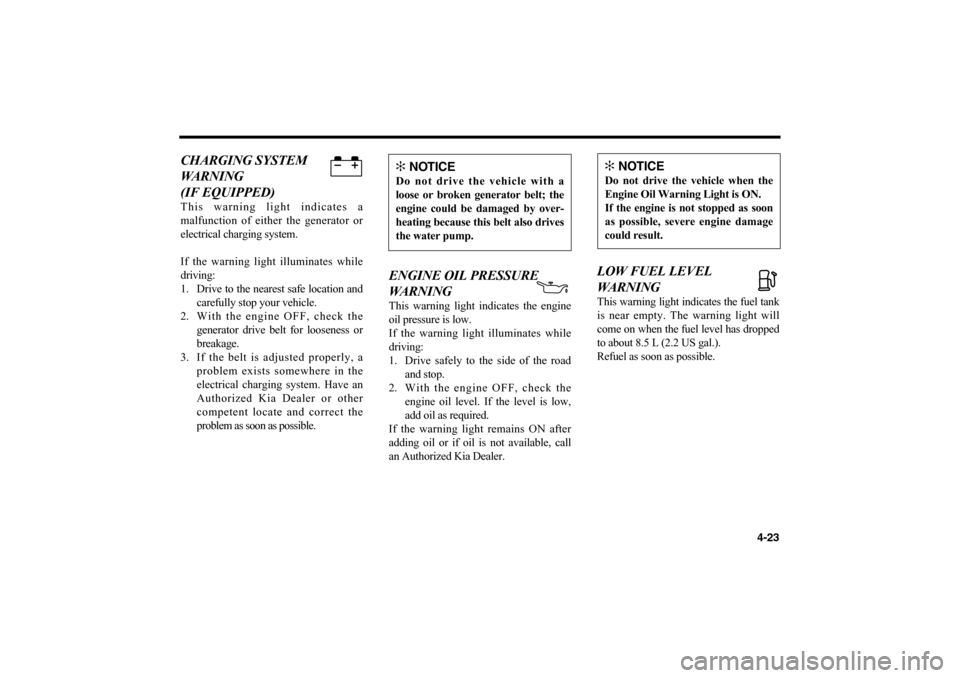
CHARGING SYSTEM
WARNING
(IF EQUIPPED)This warning light indicates a
malfunction of either the generator or
electrical charging system.
If the warning light illuminates while
driving:
1. Drive to the nearest safe location and
carefully stop your vehicle.
2. With the engine OFF, check the
generator drive belt for looseness or
breakage.
3. If the belt is adjusted properly, a
problem exists somewhere in the
electrical charging system. Have an
Authorized Kia Dealer or other
competent locate and correct the
problem as soon as possible.
ENGINE OIL PRESSURE
WARNING This warning light indicates the engine
oil pressure is low.
If the warning light illuminates while
driving:
1. Drive safely to the side of the road
and stop.
2. With the engine OFF, check the
engine oil level. If the level is low,
add oil as required.
If the warning light remains ON after
adding oil or if oil is not available, call
an Authorized Kia Dealer.
LOW FUEL LEVEL
WARNING This warning light indicates the fuel tank
is near empty. The warning light will
come on when the fuel level has dropped
to about 8.5 L (2.2 US gal.).
Refuel as soon as possible.
4-23
✻
NOTICE
Do not drive the vehicle with a
loose or broken generator belt; the
engine could be damaged by over-
heating because this belt also drives
the water pump.
✻
NOTICE
Do not drive the vehicle when the
Engine Oil Warning Light is ON.
If the engine is not stopped as soon
as possible, severe engine damage
could result.
MS-CNA-Eng 4(~39).QXD 7/25/2005 5:16 PM Page 23